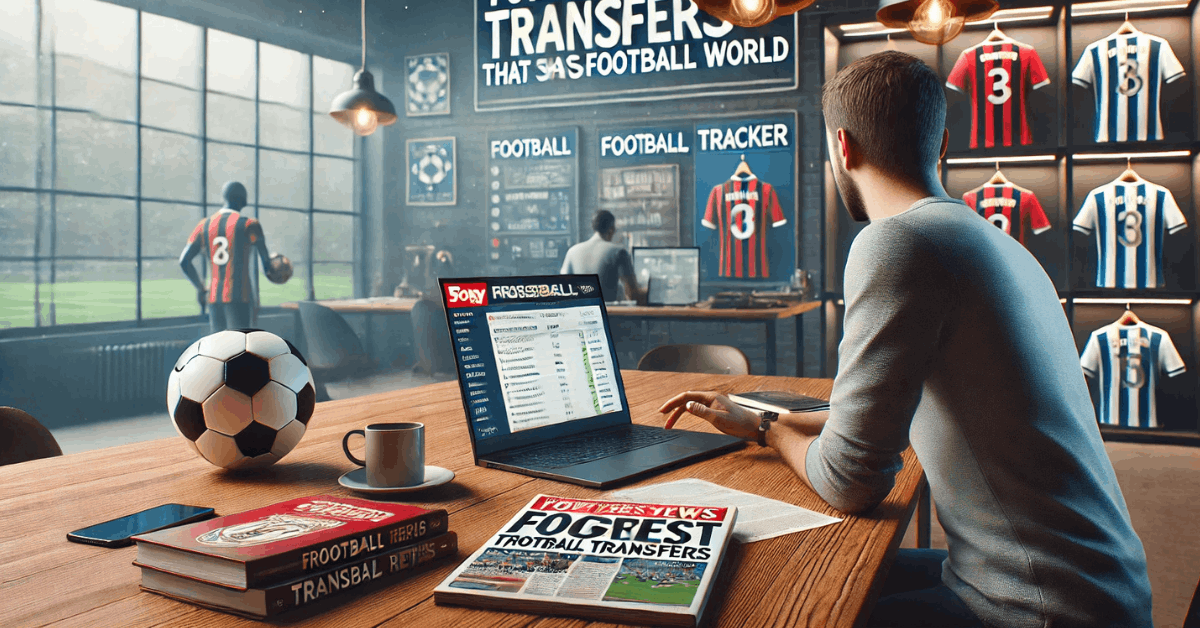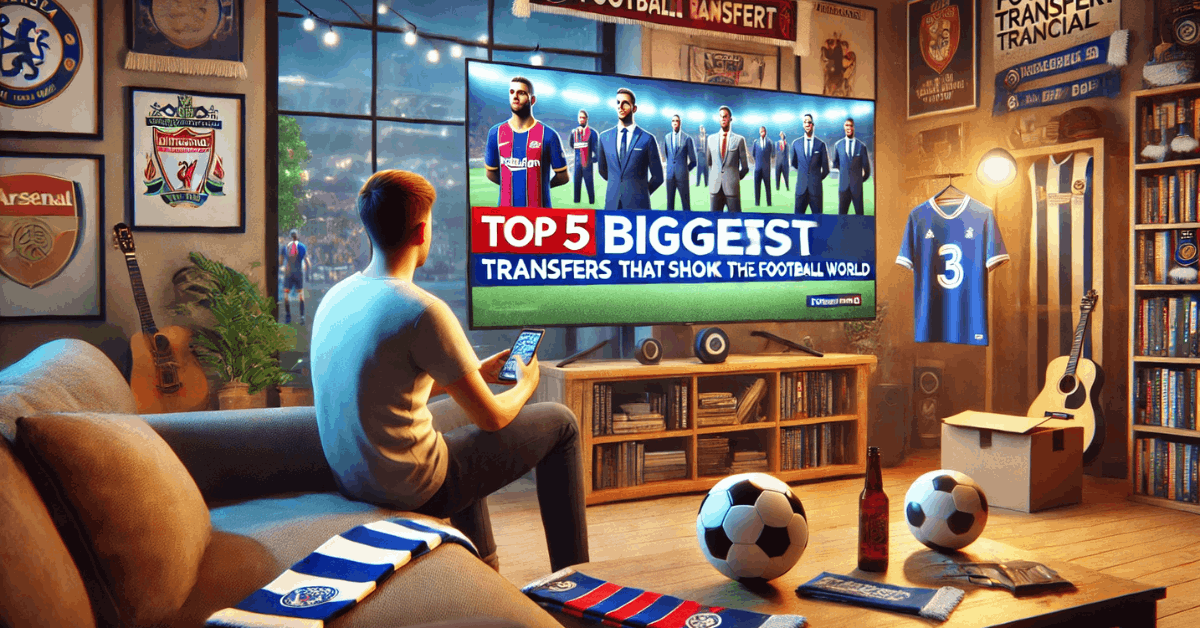The football world has seen countless transfers, but only a few truly changed the sport. The 5 biggest transfers didn’t just involve massive fees—they shifted power across leagues.
They influenced club strategies and shaped football eras. These five stories show why certain moves matter more than others.
Why These Transfers Shook the World?
Some transfers go beyond football—they shift the direction of the sport. They bring huge financial changes and global attention. Fans, clubs, and leagues all feel the effect.

5 Era-Defining Transfers That Changed Football Forever
Some transfers do more than make headlines. They redefine football eras. These are five of them.
1. Cristiano Ronaldo to Real Madrid - 2009
Cristiano Ronaldo’s move from Manchester United to Real Madrid was more than a record-breaking deal. It marked the start of a new era in football business. It changed competition in Europe.
Real Madrid paid €94 million to bring Ronaldo from Manchester United. His arrival was part of the Galácticos project. Ronaldo made Real Madrid a marketing powerhouse.
On the pitch, he delivered consistently with over 450 goals. He won four Champions League titles. His rivalry with Messi drew global attention.
2. Neymar to Paris Saint-Germain - 2017
Neymar’s transfer to PSG didn’t just break records. It redefined the entire transfer market. Nothing was the same after this.
In 2017, PSG paid €222 million to activate Neymar’s release clause. It’s still the highest transfer fee ever. PSG used the move to grow its global brand.
Neymar boosted Ligue 1’s profile. The transfer caused inflation across the market. Barcelona struggled to replace him effectively.
3. Lionel Messi to Paris Saint-Germain - 2021
Messi’s transfer wasn’t about money. It exposed club mismanagement. Nobody expected him to leave Barcelona.
Messi joined PSG on a free transfer in 2021. Barcelona couldn’t register his contract. La Liga’s financial rules blocked the deal.
The move stunned fans worldwide. PSG gained unmatched star power. Barcelona entered a painful rebuild.
4. Kylian Mbappé to Paris Saint-Germain - 2018
Mbappé’s transfer changed how clubs value young talent. Age no longer limited price tags. This was a statement move.
PSG signed Mbappé from Monaco for €180 million. It was the most expensive deal for a teenager. The loan structure helped bypass FFP.
Mbappé became a top scorer in Europe. His 2018 World Cup run raised his profile. The move made PSG future-focused.
5. Zinedine Zidane to Real Madrid - 2001
Zidane’s move to Real Madrid was one of the first blockbuster transfers. It set a template for future deals. The fee was historic at the time.
In 2001, Real Madrid paid €77.5 million for Zidane. He became the core of the Galácticos project. The deal was both strategic and commercial.
Zidane won the Champions League with a famous volley. Shirt sales and viewership spiked. Years later, he returned as a successful manager.
Additional Factors That Made These Transfers Historic
Big transfers don’t just change clubs. They reshape how the sport works. That includes media, finance, and long-term planning.

Media Coverage and Fan Reactions
Media coverage amplifies the impact beyond the field. These five moves led global headlines for weeks. Fans posted nonstop reactions.
Social media exploded after each announcement. Shirt sales broke records within hours. Clubs used these signings for digital growth.
These transfers became full-blown media events. They connected fans around the world. Each move turned into global buzz.
Financial Ripple Effects
Each of these transfers pushed financial boundaries. Neymar’s fee forced clubs to rethink how they structure deals and contracts.
PSG’s back-to-back signings of Neymar and Mbappé led UEFA to monitor Financial Fair Play violations more closely.
Clubs began protecting their players with higher release clauses. Sponsorship deals and ticket prices were adjusted to cover the costs. The impact rippled through agents, brands, and even youth academies.
Club Strategies Post-Transfer
Transfers at this scale don’t end with the announcement. They shape how clubs move forward for years. Below are the key effects on club strategies:
- Barcelona struggled after Neymar’s departure, spending large fees on underperforming replacements.
- Real Madrid restructured its identity around Cristiano Ronaldo’s success and marketing appeal.
- PSG leaned heavily into its attacking trio, using Neymar and Mbappé as long-term branding and tactical pillars.
- Clubs had to adjust tactics and finances based on their new stars, often restructuring budgets and lineups.
- These moves influenced long-term recruitment strategies, youth investment, and sponsorship models.
- Reputation, competitive edge, and global fan engagement were all shaped by how clubs handled post-transfer transitions.
The Bigger Picture — Evolving Dynamics in Football Transfers
Transfers aren’t just about switching clubs. They reflect deeper shifts in the football ecosystem. Here’s how those shifts continue to evolve.
The Rise of Player Power
Players today have more control than ever before. They influence club decisions and transfer negotiations. Agents and personal brands amplify this power.
Contract clauses like release options and loyalty bonuses are now common. Players dictate terms rather than clubs. It’s a shift in leverage and influence.
This trend shapes how clubs approach renewals. Negotiations now focus on incentives and control. Player power has changed the transfer process.
Technology and Data in Transfer Decisions
Analytics now guide transfer strategies. Clubs use data to assess performance and potential. It reduces risk and improves scouting accuracy.
Tracking tools monitor player movement and health. Video analysis helps with tactical fit. Clubs rely on numbers more than instinct.
This shift favors well-managed clubs. They invest in tech to stay competitive. Poor planning gets exposed in the data era.
Impact of Social Media on Transfer Hype
Social media transformed how football transfers unfold. News spreads faster than clubs can respond. Hype builds instantly, even before confirmation.
- Leaks and transfer rumors gain traction quickly across platforms like Twitter and Instagram.
- Players tease fans through cryptic posts or emoji responses, fueling speculation.
- Clubs capitalize on the buzz to time announcements, boost engagement, and drive merchandise sales.
- Fans create narratives through memes, predictions, and viral videos, which influence public opinion.
- Transfer windows become media events, with real-time updates, livestreams, and influencer coverage.
- Sponsorship and ad revenue grow as clubs attract more views, shares, and interactions during transfer talks.
Summing Up — How These Transfers Changed Football Forever?
These five transfers weren’t just expensive. They changed how football works. You’ve seen their impact on teams and the sport itself.
Each move had ripple effects still felt today. They shaped club strategy, media, and markets. Understanding these deals helps you follow the modern game.






